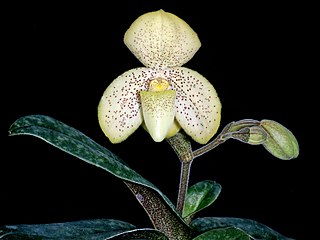
Masdevallia, abbreviated Masd in horticultural trade, is a large genus of flowering plants of the Pleurothallidinae, a subtribe of the orchid family (Orchidaceae). There are over 500 species, grouped into several subgenera. The genus is named for Jose Masdevall (?-1801), a physician and botanist in the court of Charles III of Spain.

Cypripedioideae is a subfamily of orchids commonly known as lady's slipper orchids, lady slipper orchids or slipper orchids. Cypripedioideae includes the genera Cypripedium, Mexipedium, Paphiopedilum, Phragmipedium and Selenipedium. They are characterised by the slipper-shaped pouches of the flowers – the pouch traps insects so they are forced to climb up past the staminode, behind which they collect or deposit pollinia, thus fertilizing the flower. There are approximately 165 species in the subfamily.

Paphiopedilum, often called the Venus slipper, is a genus of the lady slipper orchid subfamily Cypripedioideae of the flowering plant family Orchidaceae. The genus comprises some 80 accepted taxa including several natural hybrids. The genus is native to Southeast Asia, the Indian Subcontinent, southern China, New Guinea and the Solomon and Bismarck Islands. The type species of this genus is Paphiopedilum insigne.

Phragmipedium is a genus of the Orchid family (Orchidaceae) and the only genus comprised in the tribe Phragmipedieae and subtribe Phragmipediinae. The name of the genus is derived from the Greek phragma, which means "division", and pedium, which means "slipper". It is abbreviated 'Phrag' in trade journals.

Cymbidium, commonly known as boat orchids, is a genus of evergreen flowering plants in the orchid family Orchidaceae. Orchids in this genus are epiphytic, lithophytic, terrestrial or rarely leafless saprophytic herbs usually with pseudobulbs. There are usually between three and twelve leaves arranged in two ranks on each pseudobulb or shoot and lasting for several years. From one to a large number of flowers are arranged on an unbranched flowering stem arising from the base of the pseudobulb. The sepals and petals are all free from and similar to each other. The labellum is significantly different from the other petals and the sepals and has three lobes. There are about fifty-five species and sixteen further natural hybrids occurring in the wild from tropical and subtropical Asia to Australia. Cymbidiums are well known in horticulture and many cultivars have been developed.

A botanical name is a formal scientific name conforming to the International Code of Nomenclature for algae, fungi, and plants (ICN) and, if it concerns a plant cultigen, the additional cultivar or Group epithets must conform to the International Code of Nomenclature for Cultivated Plants (ICNCP). The code of nomenclature covers "all organisms traditionally treated as algae, fungi, or plants, whether fossil or non-fossil, including blue-green algae (Cyanobacteria), chytrids, oomycetes, slime moulds and photosynthetic protists with their taxonomically related non-photosynthetic groups ."

Selenipedium is a genus of the Orchid family (Orchidaceae). The genus has been given its own tribe, Selenipedieae, and subtribe, Selenipediinae. It is abbreviated Sel in trade journals.

Calanthe, commonly known as Christmas orchids, is a genus of about 220 species of orchids in the family Orchidaceae. They are evergreen or deciduous terrestrial plants with thick roots, small oval pseudobulbs, large corrugated leaves and upright, sometimes arching flowering stems. The sepals and petals are narrow and a similar size to each other and the labellum usually has spreading lobes.

Paphiopedilum glaucophyllum, common name shiny green leaf paphiopedilum or tropical lady's-slipper, is a species of flowering plant in the genus Paphiopedilum of the family Orchidaceae.

Disperis is a genus of plants in the orchid family, Orchidaceae. It has about 78 species. Most of the species are from tropical and southern Africa, as well as Indian Ocean islands. A few are native to the tropical or the warmer subtropical regions of Asia and Malesia.

Paphiopedilum charlesworthii is a species of plant in the family Orchidaceae.

Paphiopedilum gratrixianum is a species of plant in the family Orchidaceae found from Laos to Vietnam.

Paphiopedilum vietnamense is a species of orchid found from Thái Nguyên Province in Vietnam. It was discovered in 1997 and it is endangered.

Paphiopedilum parishii is a species of orchid found in northern and western Thailand, Laos, Myanmar, Yunnan and Assam, in montane forests at 1200–2200 m above sea level. It is named after Charles Samuel Pollock Parish, an English botanist and avid plant collector who had a particular interest in the flora of Myanmar.

Vanilla siamensis is a plant species of southern China, Thailand, Cambodia, and Vietnam. It is an epiphyte that occurs in montane evergreen forests.

Paphiopedilum subgenus Parvisepalum is a subgenus of the genus Paphiopedilum.

Paphiopedilum subgenus Brachypetalum is a subgenus of the genus Paphiopedilum.

Paphiopedilum subgenus Cochlopetalum is a subgenus of the genus Paphiopedilum.

Paphiopedilum subgenus Paphiopedilum is a subgenus of the genus Paphiopedilum.

Paphiopedilum subgenus Sigmatopetalum is a subgenus of the genus Paphiopedilum.






























